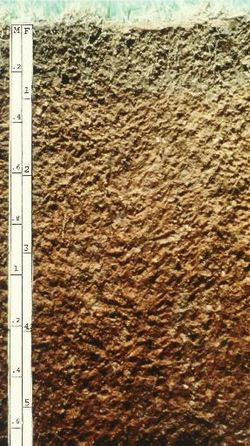Alfisols
| Alfisol | |
|---|---|

an Alfisol profile
|
|
| Used in: | USDA soil taxonomy |
| Climate: | various |
Alfisols are a soil order in USDA soil taxonomy. Alfisols form in semiarid to humid areas, typically under a hardwood forest cover. They have a clay-enriched subsoil and relatively high native fertility. "Alf" refers to aluminium (Al) and iron (Fe). Because of their productivity and abundance, the Alfisols represent one of the more important soil orders for food and fiber production. They are widely used both in agriculture and forestry, and are generally easier to keep fertile than other humid-climate soils, though those in Australia and Africa are still very deficient in nitrogen and available phosphorus. Those in monsoonal tropical regions, however, have a tendency to acidify when heavily cultivated, especially when nitrogenous fertilizers are used.
In the FAO soil classification, most Alfisols are classified as Luvisols or Lixisols, but some are classed as Nitosols.
Alfisols occupy around one-tenth of the Earth's ice-free land surface. They are dominant in many areas, such as the Ohio River basin in the United States, southern and unglaciated Western Europe, the Baltic region and central European Russia, the drier parts of Peninsular India, Sudan in Africa, and many parts of South America.
Alfisols have undergone only moderate leaching. By definition, they have at least 35% base saturation, meaning calcium, magnesium, and potassium are relatively abundant. This is in contrast to Ultisols, which are the more highly leached forest soils having less than 35% base saturation. In eastern North America, Alfisols are commonly found in glaciated areas while Ultisols are restricted to the areas south of the limit of maximum glaciation.
...
Wikipedia
